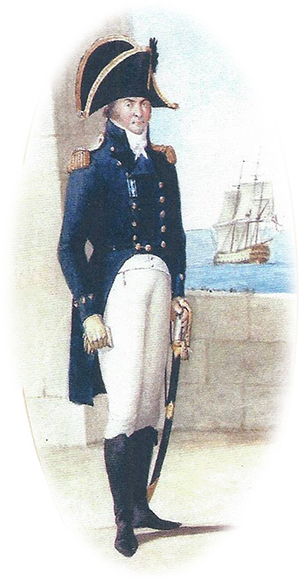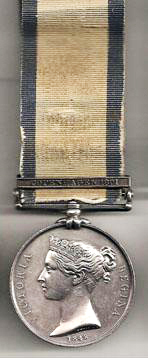If only I could talk: The Naval General Service Medal with Copenhagen 1801 Bar
I was awarded to Commander William Milne of the Royal Navy in 1848. This is my history.

My owner was born in 1782 in Carron, a village just west of Edinburgh known famously for production of the Carronade cannon, fitted into just about every British man-of-war in the fleet. William learned about cannons from his grandfather, who would take him to the smelting yards, where he worked for The Carron Company; a lawyer from its inception in 1760.
His father, also a William, was a first lieutenant and a captain in the Royal Navy for 33 years. He was on the ship when Britain captured and transported Napoleon Bonaparte to prison on St. Helena's Island. He would have been awarded one of my medals with bars for battles in Abukir Bay, Egypt and Montevideo, Uruguay, but he died in 1826 in Upper Canada. He would have had to have been alive in 1847 to be awarded the NGS medal.
I was minted in London in 1847, from silver and iron, with the shiny figurehead of my young Queen Victoria on my face and my reverse a sculpture of Britannia with her trident, seated on a sea horse. The image is intended to display our speed and length of travel over the oceans of the world, guarded by the goddess of courage and safety.
You know that "Britannia ruled the waves," and I liked being owned by brave naval crews! Almost 21,000 originals of my NGS were awarded, with some 230 different clasps made for attachments so I could hang proudly from a ribbon of navy blue and white on the chests of brave and salty mariners. My owner, William Milne, had his name inscribed on my edge.
Commander William Milne earned me and the clasp for Copenhagen in 1801, but would have to wait 47 years to receive me. He served on board HMS Elephant at the Battle of Copenhagen. He was just a young "limey" — a new recruit with a midshipman's posting. The battle was pretty scary; the Danish fleet and their shore batteries had the ability to blow a hole right through our ship's walls, and take a head clean off in the process. Captain Nelson was on board, and this had a big influence on the crew; he was beaming with confidence, and at one point, held his telescope up to his blind eye when the signals from the fleet's flag ship instructed us to retreat. We were sweating from fear of close action as we sailed into the harbour and blasted the tar out of the enemy. We won the battle that day.
My owner spent 43 years in the Royal Naval service in Britain, the Canadas, on the Seven Seas and in the West Indies, was an Upper Canada provincial naval captain on the Great Lakes and later a commander, retiring on his ranch outside of Melbourne, Australia in 1847. With prize money and land grants, and on half-pay of the Royal Navy, he could live comfortably, and Naval lists raised him to master and commander rank. A warm estate retirement was what he needed.
So this is how I traveled
I was put on a British warship sailing to Melbourne. There I sat safely in a treasure chest at the ranch, and after my owner died in 1851, I was willed to his brother, Capt. Alexander S. Milne, in Canada. I was again put onto a British warship and sent half way around the world, and up the St. Lawrence to Hamilton/Ancaster, in Canada. Alexander Milne was a barrister who kept me in a drawer at home, and upon his death in 1864, willed me to his son, James G. Milne, also a solicitor, who rode horseback out west in search of gold and adventure. James served in the Fenian Raids of 1866 and the Riel Rebellion of 1885. His medals were added to my collection.

When James settled and speculated on lands in Qu'Appelle, Northwest Territories in 1883, I was transported on the new CPR railway, and I resided on the Milne farm for 45 years until 1925. My owner died in 1929, and I was willed to his son, Alexander G. Milne, who ran the farm. When the farm was sold, I was packed in the family trunk, and carried on a 1917 Maxwell across a dusty prairie to Wabamun Lake, west of Edmonton. There I sat for four years, until my owner moved me by a 1932 Buick to Calgary in 1933. I resided in Alexander's downtown apartment for 11 years, until he died in 1943, and his wife gave me to their eldest son, Sgt. Harvey W. Milne, who had been serving the Canadian Army in England, not far from where I was minted. I was stored in his home in the trunk for 40 years.
In 1983, Harvey gave me to his eldest nephew, Garry Milne. Harvey died in Calgary in 2007. Garry had moved me to St. Albert, and I remained in his home for 25 years,while he researched my origins. He found detailed naval service records of my original owner, and his naval father at KEW in London. Now I sit proudly displayed for all to see. My ribbon was almost gone, so a shiny new one was attached, but you can still see my original one. I am happy to be on display.
So here I am, mounted in a display case along with some 36 other family war medals — the older ones are as issued, with some of the WW2 medals purchased and made into sets, as the originals had been passed on to their children. What will they do? Each war medal has a family story, and war service was a big part of their lives. While veterans don't want to talk, the inheritors of these medals want to know their stories. It remains with the present generation to do the research and keep the records for the future.
If I could talk, you would be impressed. 166 years later, and my seafaring captain's request has been faithfully followed. I am still in the family! How is this possible? Families don't normally keep war medals; they sell them for financial gain; at least most do. Others just don't care. This story is unusual and unique. Future generations must know stories about the owner. Commander William Milne has quite an interesting story, told here all too briefly. It's about him wanting to keep the medal in the family. It would appear his last wishes and commands have been fulfilled, as it is proudly displayed in Calgary.
— Garry Milne
